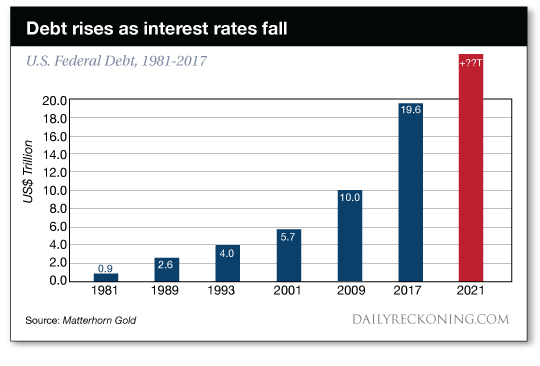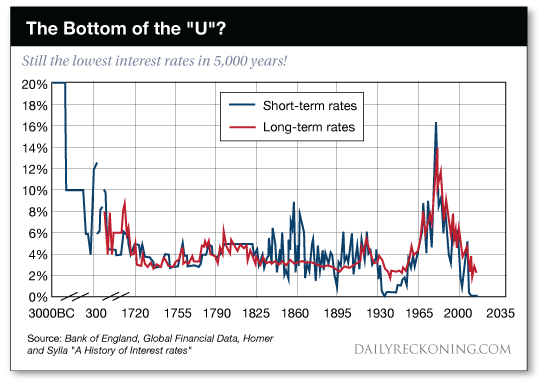By Brian Maher
This post Interest Rates and Civilization appeared first on Daily Reckoning.
We have it on superb authority — the Institute of International Finance — that the world is presently $247 trillion in debt.
That figure, dear reader, represents a record high.
Global debt has surged $9 trillion since Jan. 1 alone… and $30 trillion since the close of 2016.
Were you aware that global debt is rising nearly three times the rate of global wealth?
Meantime, global interest rates remain near record lows — despite recent nods in the other direction.
Never in history has debt scaled such heights… never have interest rates plumbed such depths.
Each fact is remarkable in itself. But taken together?
Today we connect the dots… see how they all tuck together… and tease out the implications.
Richard Sylla professes economics at New York University.
He is also co-author of A History of Interest Rates (available through Amazon at a bargain-bin $63 per).
This book canvasses 5,000 years of interest rates… from ancient Babylonia to the glories of Greece and Rome… the Renaissance, the age of empires… all the way through to the 21st century.
Each historical epoch is distinct.
The investigator hunting meaningful comparisons between eras can be easily thrown off the scent… and end down a blind alley.
Yet despite the false leads and dead ends, Sylla believes he’s penetrated the mysteries of interest rate cycles throughout history:
“It seems like there is a U-shaped cycle for each civilization.”
Beginning at the top left of the “U,” interest rates begin a downward cycle.
Critically, Sylla’s research shows that as interest rates fall… civilizations rise.
Civilizations crest as interest rates near the bottom of the “U.”
These civilizational heights bring heroic deeds… great achievements… and golden ages.
Sylla claims this pattern was visible with Babylon, Greece, Rome.
In each case, Sylla observes “a progressive decline in interest rates as the nation or culture developed and throve.”
Near the turn of the 20th century, famous Austrian economist Eugen von Böhm-Bawerk glimpsed the same phenomenon. Writes Sylla:
Böhm-Bawerk declared that the cultural level of a nation is mirrored by its rate of interest: The higher a people’s intelligence and moral strength, the lower the rate of interest.
(Caveat: We speak here of market interest rates — before central banking in its current form.)
But eventually the gods grow anxious of man’s advancing knowledge… his increasing achievements… his ascent up Olympus.
They know the solution…
The gods begin to tinker with man’s interest rates.
Rates start rising off the bottom of the “U,” up the right side of the slope.
The burden of accumulated debt rises with them.
The added weight throws chains upon civilization… the flame of achievement flickers… and it finally fades.
In this manner, each civilization Sylla studied “declined and fell.”
The message, clear as gin:
Civilization rises with falling interest rates. Fattened by debt… civilization falls with rising interest rates.
Now come home…
The year is 2018. Interest rates have begun to rise recently — if slowly — and haltingly.
They still remain at lows unseen in recorded history, besides a brief spell during the Great Depression:
But all cycles end… and history will not be forever put off.
Rates will return to “normal” one day.
If rates rise meaningfully in the years to come, is civilization in for a sharp “decline and fall” as befell civilizations past?
Sylla thinks yes, it’s possible:
We might say that our current low interest rates indicate that we’re at one of the high points of our civilization. Maybe things will get worse from now on.
Recall that civilizations gorge on debt in a falling rate environment… and collapse under that debt as interest rates rise.
Let us now redirect our focus to a unique form of civilization — American civilization.
U.S. interest rates have been in steady decline since their 1981 peak.
Meantime, the national debt has exploded:

Today the national debt runs to $21 trillion — and counting.
How will America service that debt if rates return to historically normal levels?
We hadn’t the heart to run the numbers. Financial analyst Daniel Amerman did:
If the interest rate on that debt were to rise by even 1%, the annual federal deficit rises by $200 billion. A 2% increase in interest rate levels would up the federal deficit by $400 billion, and if rates were 5% higher, the annual federal deficit rises by a full $1 trillion per year.
Incidentally… 5% higher are rates well within historical norms.
If interest rates do rise to historical levels and their relationship to civilization holds true…
Perhaps we should all light a candle for civilization…
Below, Charles Hugh Smith shows you why the stability of America’s status quo is an “illusion.” What comes next? Read on.
Regards,
Brian Maher
Managing editor, The Daily Reckoning
Editor’s note: For now, interest rates are still extremely low and the stock market is once again flirting with record highs.
Which is why we want to let you in on a secret our colleague just shared with us, a secret he had been holding onto…
It’s about how he made his millions… and let’s just say it’s not how most people do. He says anyone can do it if only they knew how. Now he’s telling all.
He trusted us not to share this one-minute clip with too many people, so we agreed to take it off the web Sunday at midnight.
If you really want to change your financial future, take one minute to [watch this short clip].
It could turn out be the most valuable minute of your life. Go here now.
The Stability of America’s Status Quo Is an Illusion
By Charles Hugh Smith
The stability of America’s status quo is an illusion.
One of the enduring mysteries of the past decade is why inflation has remained tame while the central bank and government have pumped trillions of dollars of newly created money into the economy. Millions of words have been written about this, and so some shortcuts will have to be taken to make sense of it in one essay.
Let’s start with the basics.
Adding newly created money but not generating new goods and services of the same value reduces the purchasing power of existing money.
To keep it simple: say …read more
From:: Daily Reckoning

